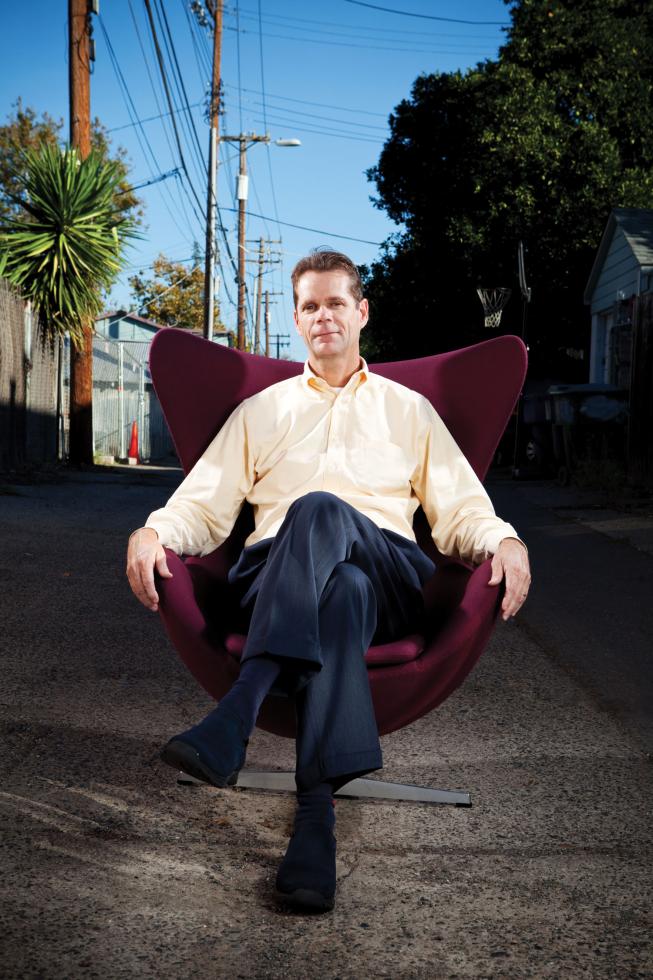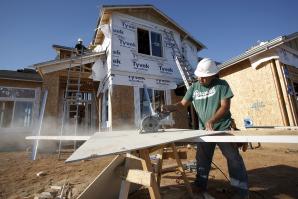Allen Folks, principal with architecture and environmental
consulting company EDAW Inc. says to look for a mix of
alternative housing options in the future, such as small side
yards and alley entrances.

It might be hard to imagine, but Sacramento will start building thousands of houses and condominiums again — some day.
They won’t look like the homes that flooded the market a few years ago, say the people who build the product and measure the demand. The homes won’t be the same size or appear in quite the same kinds of places either.
But they’re coming.
“Clearly when you look at the population numbers, even with the slowdown in growth, we still don’t have enough housing to meet the needs of California,” says Greg Paquin, president of The Gregory Group, a market research firm in Folsom.
From 2005 to 2035 Sacramento County could add more than 290,000 houses and condos, according to estimates by the Sacramento Area Council of Governments. Placer County would add more than 100,000, Yolo County nearly 45,000, El Dorado County about 26,000, Yuba County more than 32,000 and Sutter County more than 20,000.
It averages about 17,500 a year for the six-county region, a projection made in 2008 when the local housing market was already deep in the doldrums.
The biggest difference in housing choices, at least to start, will be the size. Some sources expect 1,300 square feet to be the new norm. Others peg it at 1,500 or even 1,800, but none expect many more of the 4,000-square-footers that went up in recent years.
The main reason is price. From 1985 to 1998, new housing prices in the Sacramento region held steady at roughly four times the median income, according to a study by The Gregory Group and Economic & Planning Systems Inc. From 1999 to 2005, the ratio shot up to nine times the median income.
Now, with the flood of foreclosures, a rotten economy and the end of fast-and-loose lending, fewer residents can even consider a big-ticket house.
Last year nearly 40 percent of first-time homebuyers said they wouldn’t have closed a deal at all if not for the federal tax credit for first-time buyers, according to the California Association of Realtors. The tax credit and low prices were the primary reasons respondents bought homes this year according to the association. The credit is set to expire in December unless Congress extends it.
“We have to build what the customer wants, not what we as builders or city councils think should be on a lot. In the last cycle that is kind of what we got away from,” says Chris Cady, Sacramento division president of Pulte Homes Inc. “We forgot about the first-time buyers or the recent newlyweds, where traditionally you would start with a 1,500-square-foot house. We kind of fast-forwarded that and put them right in a 3,000-square-foot house.”
Pulte has a good record of judging the market. This year the company and its Del Webb and Centex subsidiaries swept the three top spots in the J.D. Power and Associates New-Home Builder Customer Satisfaction Study for the Sacramento Market.
The other part of keeping prices down is to reduce fees, Cady says.
“That’s where some of the systemic change needs to occur,” he says. “Clearly builders need to pay for the impacts we incur, but where the recalibration needs to take place is [in] the amount of the impact.”
It’s already happening in some quarters.
“The biggest change we will see in the future is not necessarily design on housing but a design of the communities.”
Greg Paquin, president, The Gregory Group
“Woodland reduced fees. Elk Grove reduced fees. Lincoln and Folsom are considering it,” says Tim Youmans, managing principal at Economic & Planning Systems Inc.
The same thing happened with fees that happened with the housing itself, he says. “They kept building more extravagant stuff and raising standards.”
If there’s no way to bring down the cost to developers, it may be time to explore alternatives to fees, Cady suggests. California has taken that approach before with the creation of Mello-Roos districts. Bond money covers the cost up front, and a special tax pays it back over a fixed period.
The smaller houses of the future may also look different inside than their predecessors. Opinions differ as to what form they will take, but Katherine Boyce, regional sales director for Hanley Wood Market Intelligence, says new homebuyers are geared to do more at home. They want more open floor plans and won’t be as happy with “mouse-box” bedrooms.
Some builders predict simpler interiors with fewer granite countertops and other fancy details that increase costs. Others expect amenities to get even fancier to make up for smaller spaces.
Along with smaller houses we may see smaller lots.
“The cost of finished lots is still expensive, so everybody has to find ways to cut costs to meet what the buyer can afford,” says Allen Folks, a principal with architecture and environmental consulting company EDAW Inc., and chair of the Urban Land Institute’s Sacramento district council.
“In general, the lot sizes are shrinking,” he says. “That’s a trend that is probably here to stay.” Look for the mix of housing styles to include very small side yards and alley entrances on some lots.
All of these changes might be hard to discern at the onset of the housing revival. The region is dotted with subdivisions that had already received entitlements and approvals when the housing market crashed. Builders might want to pick up where they left off as some of the changes were already manifesting in the newest projects.
“It takes 10 years to get a project approved,” Youmans says. “Those built in the late ’90s were approved in the late ’80s and early ’90s.” The projects that are ready to go already had a greater mix of housing styles and densities, plus clusters of commercial real estate, or town centers.
“The interesting thing is what that means after five to 10 years,” Paquin says. “I happen to think the biggest change we will see in the future is not necessarily a design on housing but a design of the communities.”
The town center idea mimics older, downtown areas that have begun attracting young singles and empty nesters. Scott Blunk, founder of GreenBuilt Construction Inc., tells of a middle-age couple that wants to downsize now that they can no longer count on home equity as a ready source of cash.
“They are a little more afraid of overextending themselves,” Blunk says. “They are trying to get down to one car, get to a place where they can walk to the grocery store. Maybe they are a little more fearful that their money won’t be there when they need it, so they want to live a life where they will depend less on it.”
Sacramento has the opportunity to provide downtown housing of historic proportions in the railyards, a project that is now finally seeing new infrastructure after decades of deal making and preparation. The city’s plan calls for more than 10,000 apartments and condominiums, both rentals and for-sale units.
“There will be some very cool downtown stuff,” Cady says. “There is a buyer profile who will want to do that, who wants to be able to walk to work or take light-rail.” But the downtown, urban crowd is not the whole housing market.
“Where we need to be careful is that we not group everybody into these very small buckets,” Cady says.
Greenfield building will still be a major part of the housing picture. Right now a developer can buy subdivided land on the edges of towns for less than what it costs others to prepare it for construction, Blunk notes. And there is still strong demand for suburban living.
“It’s the middle group that has children that tend to move out in the suburbs and buy detached housing to raise their families. That hasn’t really changed,” Paquin says. What will change, he says, is the car-centric focus of the traditional suburb.
“Where we need to be careful is that we not group everybody into these very small buckets.”
Chris Cady, Sacramento division president, Pulte Homes Inc.
“You are going to see subdivisions where the kids can ride their bikes to school without having to ride on the streets,” Paquin says. “There will be ways of connecting the cul-de-sacs to schools and parks. Maybe we won’t see the 30-acre parks, but we will see pocket parks.”
Urban or suburban, the next generation of homes will be greener. Selling those features might get quirky, however. The new generation of homebuyers wants green but doesn’t want to pay a lot for it, Boyce says. If one builder can put green features into a house without raising the cost much, and all the nearby houses don’t have those features, it could have a big impact on sales, she says.
“Some have agreements with the solar companies where it works in everyone’s favor,” Boyce says. “As an example, you have The Grupe Co., who had a project out in Rocklin in the Whitney Ranch master plan. They were completely solar. Everything about it had green features built in. They literally sold quadruple the amount of everyone else.”
Cady says green comes in different shades. A home with heavy-duty insulation and a kitchen full of Energy Star appliances is already easy to find in the area. To escalate to a platinum certification from the U.S. Green Building Council is another approach entirely, one that carries a much higher price tag.
Governments, both state and local, are giving a boost to green neighborhoods. Locally, the city of Roseville has the pilot Cash for Grass Rebate Program to replace lawns with drought-tolerant plants and ease demand on the city water utility. As the city puts together its Sierra Vista specific plan, water conservation will be a major component, says John Sprague, assistant city manager for community development.
West Sacramento is drafting a green-building ordinance. Blunk says he has consulted with a half-dozen municipalities, including Davis and Sacramento County, on similar ordinances.
“Just the fact that they have those, in whatever stage they are in, it’s certainly going to raise awareness and get people thinking more about the process and what goes into the building,” he says.
At the state level, two pieces of legislation are likely to have a big impact. The California Global Warming Solutions Act of 2006 is a general attempt to reduce greenhouse gasses. Building on that legislative base, Gov. Arnold Schwarzenegger last year signed Senate Bill 375, which attempts to control greenhouse gas emissions by curbing sprawl. It sets regional goals, with incentives for local governments and developers to follow new growth patterns.
“The projects that show real strong compliance with that legislation will be the ones that garner the quickest political approval, get the most support, and maybe even get the most indirect sources of financing,” Folks says. “These may be the projects that leap ahead of the others. Those are the ones that the political agencies are going to favor.”
Whether buyers favor them could depend more than ever on location, always a real estate mantra.
“People are saying they will take less of a house to get a better neighborhood. For so long people were buying in areas that weren’t that great to get a better house,” Boyce says. “I look at Rancho Cordova and that Anatolia master plan, where the houses are phenomenal. But getting in and out of that master plan to a freeway can be excruciating. I believe that the build-it-and-they-will-come era has come and gone.”
Whatever houses and condos get built, and wherever developers build them, their annual volume will take a while to ramp up. Paquin foresees maybe 4,500 new homes a year in the near future for the immediate Sacramento area and double that a few years down the road.
“Most builders, like myself, will build slowly,” says Dave Romo, president of Sycamore Homes in Sacramento. “Instead of building 100, we are going to build 40. Then we will see.”
Efficiency quarters
One organization’s idea of a futuristic home looks a lot like the homes of the past — at least from the exterior.
Inside, it’s a different story. The Sacramento Municipal Utility District partnered with RJ Walter Homes to build a Folsom house that uses 80 percent less energy than one built to current code and has no net electrical demand from 4 to 7 p.m.
SMUD’s home of the future boasts heavy-duty insulation, a solar thermal system for heating, skylights, automated window coverings, low-flow plumbing and countertops made from recycled paper and bottles. When the work was done in September 2008, more than 90 percent of the construction debris was recycled, according to SMUD. Since buying the $625,000 house and moving in this past February, owners Mitch Wright and Bonnie Varrah have averaged $8 a month for electricity and $10 a month for natural gas, the utility says.
The 1,921-square-foot bungalow, plus a separate guest quarters, is also the first house in the area to earn a platinum certification from the U.S. Green Building Council’s Leadership in Energy and Environmental Design.
Recommended For You

New Day on Broadway
In Oak Park, the triangle is the shape of things to come
Triangular blocks are wonderful in terms of urban energy because they dictate the creation of three-sided buildings — the only kind that can fit on those awkward sites — and the result is a group of endearing “flatiron” buildings with sharp edges that stand out from their surroundings. In other words, it’s a good place to start the revival of an entire shopping destination.

Housing Market Hope
Residential projects gain momentum in Roseville
Statistics and headlines indicate doom and gloom across the country, but local developers are still building houses. In the Capital Region, Roseville leads the area in new-home construction.


